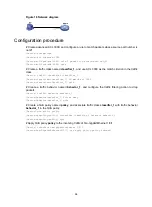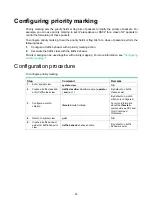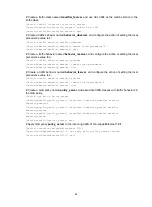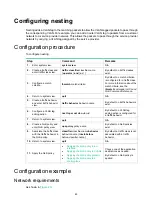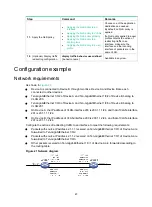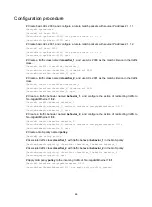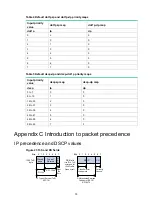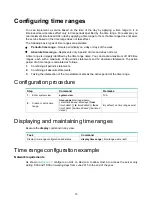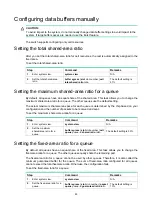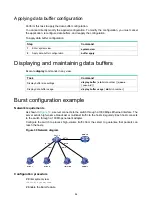
71
Configuring class-based accounting
Class-based accounting collects statistics (in packets or bytes) on a per-traffic class basis. For
example, you can define the action to collect statistics for traffic sourced from a certain IP address.
By analyzing the statistics, you can determine whether anomalies have occurred and what action to
take.
Configuration procedure
To configure class-based accounting:
Step Command
Remarks
1.
Enter system view.
system-view
N/A
2.
Create a traffic class and
enter traffic class view.
traffic classifier
classifier-name
[
operator
{
and
|
or
} ]
By default, no traffic classes
exist.
3.
Configure a match
criterion.
if-match match-criteria
By default, no match criterion
is configured.
For more information about
the
if-match
command, see
ACL and QoS Command
Reference
.
4.
Return to system view.
quit
N/A
5.
Create a traffic behavior
and enter traffic behavior
view.
traffic behavior behavior-name
By default, no traffic behaviors
exist.
6.
Configure an accounting
action.
accounting
{
byte
|
packet
}
By default, no traffic
accounting action is
configured.
7.
Return to system view.
quit
N/A
8.
Create a QoS policy and
enter QoS policy view.
qos policy
policy-name
By default, no QoS policies
exist.
9.
Associate the traffic class
with the traffic behavior in
the QoS policy.
classifier
classifier-name
behavior
behavior-name
[
insert-before
before-classifier-name
]
By default, a traffic class is not
associated with a traffic
behavior.
10.
Return to system view.
quit
N/A
11.
Apply the QoS policy.
•
Applying the QoS policy to an
interface
•
Applying the QoS policy to VLANs
•
Applying the QoS policy globally
•
Applying the QoS policy to a control
plane
•
Applying the QoS policy to a user
profile
Choose one of the application
destinations as needed.
By default, no QoS policy is
applied.
Summary of Contents for FlexFabric 5940 Series
Page 23: ...17 Figure 3 QoS processing flow ...
Page 84: ...78 Figure 26 MPLS label structure ...
Page 91: ...85 Switch burst mode enable ...


